#who knew that the best episode in the history of teen drama was made 25 years ago
Explore tagged Tumblr posts
Text

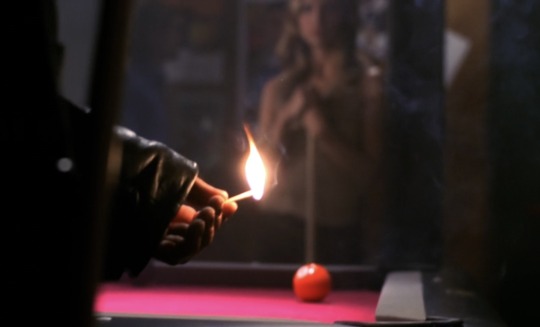
Okay WHAT was that!!!! WHY is there suddenly an episode that BREAKS me???? Leaves me GASPING for air...!
Now THAT is good tv. No no, this episode was CINEMA.
#FOOL FOR LOVE#btvs#Buffy the Vampire Slayer#Buffyverse#Spike#Buffy Summers#who knew that the best episode in the history of teen drama was made 25 years ago#the storytelling#the music#the depth!#POET SPIKE#posted#James Marsters#William the Bloody
208 notes
·
View notes
Text
Expanding into my other Fandoms (I’m gonna have to take a stance) Read the whole thing please.
One of my oldest and most beloved anime is Inuyasha. As of late I have been binged watching the hell out of it as I am getting my BFF into different anime shows. We are really close to entering the Yashahime part of the series, and she asked if I planned to write fanfiction involving the one character which made me even watch the show as a 10-year-old.

Sesshomaru
The first episode I ever watched involved this aloof, entitled dog fighting his brother over the sword in their father’s grave. Specifically, it was part 3 of that whole episode series were Kagome pulled out the sword. I at the time had 3 dogs of German Sheppard/wolf hybrid, they were MASSIVE dogs, fell in love with the big white fluff that was Sesshomaru’s demon form. I use to sneak staying up and watch the show faithfully to see the goodest boy as it was only on at 11pm EST on adult swim. Which meant it was bad and I was breaking the rules, I felt like a rebel.
Now I hesitated answering that question. She has no idea of what is in Yashahime, she is being careful not to spoil it so I told her I didn’t know. Recently, to find out what the feel is for Sesshomaru content, I looked into the tag on tumblr…
OH MY GOD.
Sesshomaru’s tag is FLOODED with hate. Like every four post, there is hate, distain, and attacking happening. As someone who watches Yashahime, I quickly knew why.
Sessrin.
Even now I sigh. And I sigh HARD. I am not for, nor am I against the Sessrin train. Same for the Sesskagu train. I think both sides need to look at things on a logical prospective. I plan to do just that. I know I will get hate from the either side and maybe some support as well. But if I am going to do anything in this fandom (as I like doing ships and reader inserts) it will come up.
So, like my Kaiba post, and my Sebastian Heel post, I will use my research skills as well as my COLLEGE DEGREE WHICH HAS BOTH ART AND MEDIEVAL HISTORY labelled on it to explain why this progression in the story is normal to anti-Sessrin fans and why this isn’t a crime by story standards nor should we look at it as a crime.
AS WELL
Explain to Sessrin fans why it is so weird for non-shippers to see it play out and why so much hate formed.
As I let out another sigh, we shall begin. Let’s start at an historical prospective. (Links at the bottom).
PLEASE READ THE WHOLE THING! I’LL BE ABLE TO TELL!
~~
I will start with the information I can access right away.
While finding charts on the life-span of common folk in 1590’s Feudal Japan is rather difficult, Ancient.edu states that the average lifespan was about 50. To put this in perspective, the average lifespan of Europeans at the time was somewhere between 40-45 with the latter being rare. Since most of us reading are not from Japanese descent, I will through Europe in this first.
If we look at the same time frame of 1590, we are looking at most of Western Europe had now entered the age of Renaissance. According to sources from Learning Resources in association with the National Gallery of Art, marriage was not what TV drama’s from HBO or Hulu depicted. By today standards they would be a crime, as the average age for marriage of an adult female was age 14…
The reasoning behind the young marriage age had multiple factors. First being, females were considered an adult once they were menstruating. Birthing also proved to be fatal, and since the lifespan was at best 40 and 45 if they were lucky, there was really no room to wait. Also Europe at the time had became hugely focused on making sure blood lines were legitimate, meaning to ensure the girl was a virgin, the moment she was able to reproduced she was married off. Those they married were not young teenagers either. Most marriages, a man would be in their thirties, and had probably multiple wives as women died more than men when not counting the battle field.
To make matters worse for the Renaissance Lady, these marriages would leave many young males unable to marry and if their husband died in battle, well, unfortunately they were not seen as desirable. This was due to the idea of a ‘free woman’. Should the girl not have a father, brother or uncle to return to as they too died, a widow had her freedom. But that freedom came at a cost. She would be assumed to have slept around, and in many writings, such as the Canterbury Tales, where Geoffrey Chaucer writes about a Window on a pilgrimage to the Holy Land survived her five husbands and the men in her family. In short, she was made to be a slut and to be looked down upon as no man controlled her.
The point of talking about Europe is because that is something most of us Non-Asian or Japanese people consume and like to paint in large romantic brush strokes of knights and magic. Honestly, reading G.R.R.Martin Song of Ice and Fire, he uses this model as we see the Queen of Dragons, Danny start off at age thirteen shortly after she had her first menstruation.
Now let’s look at Feudal Japan.
As stated before, the lifespan was around 50 years. In some populations, this was even shorter. Nagaoka, Hirata, Yokota and Matsu’ura’s on demographic data at the Yuigahama-minami area in Kamakura, Japan and found both male and female remains that suggested life expectancy to have ended around age 24-25. This was largely due to living conditions and public health. In areas like these, it would make the most sense to marry and repopulate quickly as the expectancy of life was half the national average at the time.
To my frustration, I could not find a clear marriage age for Japanese women at the time of the edo period. HOWEVER, where there is a will there is a way. I took a look at famous Lords or Daimyo’s of the time. The average age of marriage of their wives was between 12-14. Much younger than I expected, but it made sense considering this is a time where war ran the show and marriage was strictly about political gain. One of these Daimyo’s was Masamune Date, who was also 13, but then as he got older took concubines who became considerably younger than him as he became older. The goal was to have as many children as possible for hires and for political marriages to gain power.
Now lets look at Inuyasha the MANGA
Lets get the manga timeline proper here. The whole adventure took place in 11 months, a month shy of Kagome’s 16th birthday. Doing a few estimations, Rin would have travelled with Sesshomaru about 8-9 of those months. But before we get into the relationship, lets look at something the ANIME made a huge mistake with in the beginning and tried to fix as the story went on.
For some reason I could only fine gifs for the Early appearances of Sesshomaru so bear with me.
Early appearances in the manga
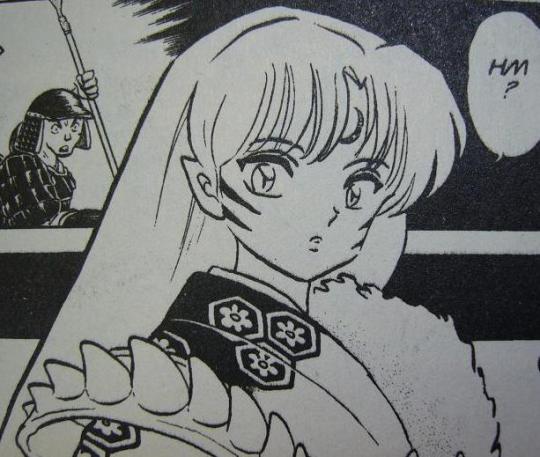
^ He was so fickle and a trickster then...

Now early apperances in the anime.
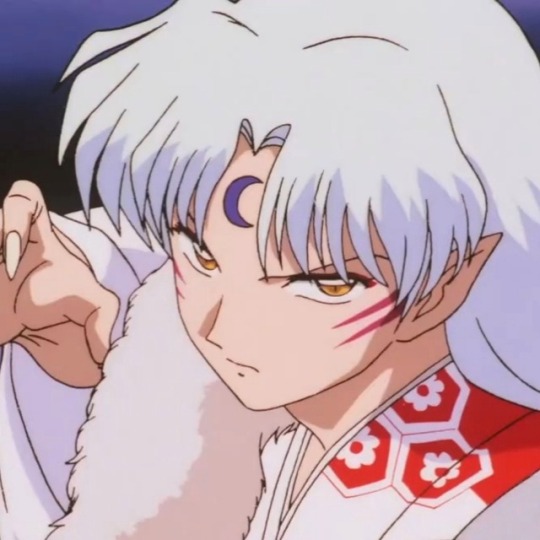
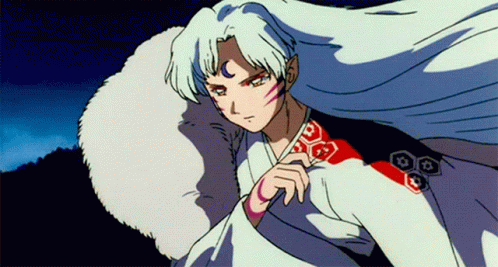
Later appearance in the manga
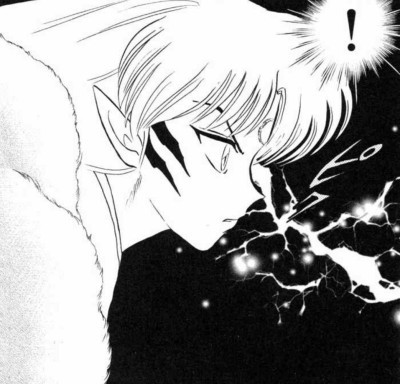
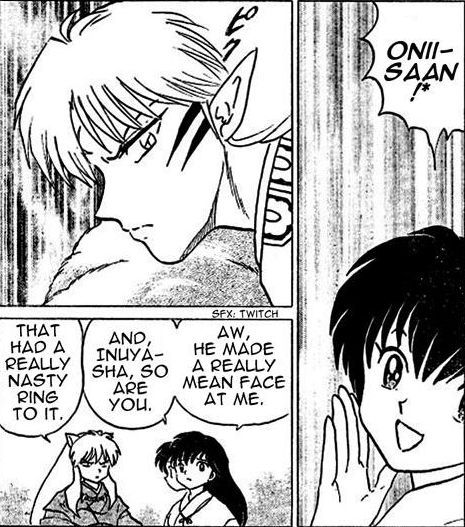
Laster appearance in the anime
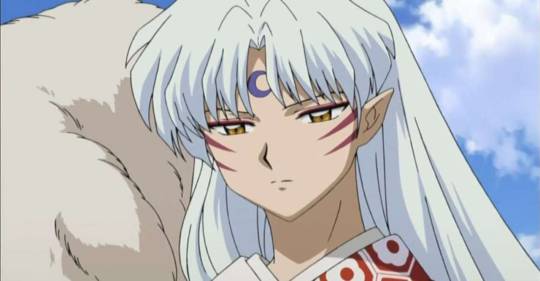

Notice the issue here?
Sesshomaru was CONSIDERABLY younger looking in the start of the manga. In the anime, he started off looking like an fully adult male. But as the anime went on, they tried to make Sesshomaru look younger with subtle changes to his jaw line, eye size, and his height. Yeah, his height had changed. They made him shorter.
While in the manga, we see this young-teen looking demon, slowly mature over 11 months to look like he is in his later teens and by series end, closer to being in his late teens or twenty. Yes, art changes over time, but the anime went a reverse route. I can only guess they spoke to the author of Inuyasha about her ships, as they did Drama CDs, and realized the mistake that was made in making him more mature than he was.
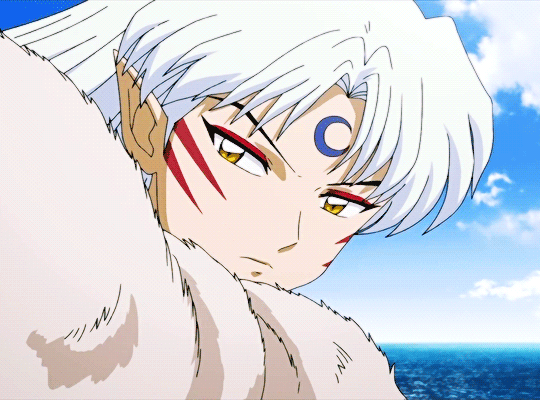

You can’t tell me he doesn’t look closer to his manga self in the final act, because he does.
Since we are on the topic of the anime, lets be clear. The anime timeline and manga timeline are very different. The story in the anime (in the English) suggests that OVER a year has past since Kagome started her journey. They try to fix this in the final act, but it was still so muddled as previous seasons are to be taken as cannon. This could have been due to an translation error in the early production when the anime no longer had anymore manga material to reference. But whatever the case, for English viewers the time the group spent together felt much longer.
So now we come to the heart of the issue.
Because of the mistakes of the anime, a lot of anti-sessrin see the relationship as father daughter. I’ll be honest, watching the anime and solely the anime as a teenager and as an adult (as the manga was on hold for a very long time due to author’s health. I was in college when it finished.), I too thought it was just a father-daughter relationship and Jaken the nanny who got punched all the time. In fact, the English took hard liberties with Kagura, as the English dubs often do with characters, and made it very clear her feelings for the demon lord and Sesshomaru very much recognized them (though he never responded). Even in her death scene, it felt as if he was saying good bye to a friend more than love interest. But who really knows, as there are things that point otherwise. When another demon mock’s Kagura’s death, Sesshomaru gets super pissy.
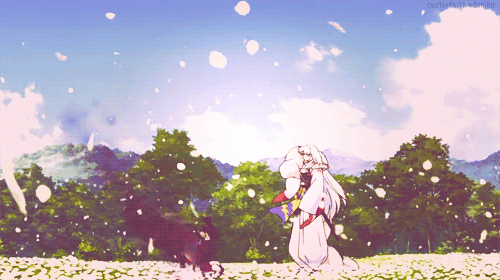
The manga did also play with this fact when it came out in English, idk if the wording or message is different in the Japanese. Translation errors happen a lot even in todays releases, look at Kuroshitsuji. So of course most anti-sessrin’s did not see this coming in Yashahime when Rin was named mother. In fact it felt like a betrayal as we were sure Sesshomaru had no romantic feelings.
Then there was the Kohaku/Rin mashup that was hinted left and right. The English anime, with its overly dramatic and blunt emotions made it appear one way. That in the end the two kids would probably be married. Then the anime as a whole made Sesshomaru older than intended. I can see why and understand how this became a problem.
On the other side of that coin.
If you followed the dub, seen ‘Swords of an Honorable Ruler’ and read the manga… Sesshomaru was not fatherly to Rin at all. In fact, Jaken picked up all of that leg work. Rin worried for Kohaku, but clearly loved Lord Sesshomaru. Sesshomaru cared about Kagura but he almost CRIED when he lost Rin.
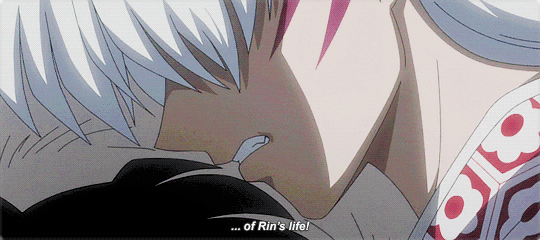
We have to remember that Sesshomaru and Rin’s relationship must have been very hard for the demon. While we never see his mental process expect for a few rare times, we have to remember he hated humans. In the movie, he blamed a human for the early death of his father, Sesshomaru killed without mercy. It made sense that he wouldn’t be fatherly to Rin as her just being there should have caused countless inner conflicts. Hell, he even says his father’s weakness was humans, and look who picked up that trait.
Sesshomaru was designed to, someday, walk in his father’s footsteps. So sess/rin, not a surprise. Also when you see it in a historical perspective, Rin having kids around age 15-16, makes sense. In fact you could argue he waited too long for the time period.
We also need to look more at the manga when concerned with Yashahime. 8-9 months is all Rin travelled with him and he was like hold up, and left her at the village because he KNEW she needed to come to her own conclusion. That no matter what she picked he would live with and protect her. Unconditional love on his end. She cannon wise spent YEARS living with humans and MONTHS with Sesshomaru. Again, by manga standards of cannon.
Now I can already hear the screaming about age and what not. Some sources say Sesshomaru is over 900, by the rule of thumb, if we look at anime and movie releases, we have Sesshomaru being over 500 with no define age and Inuyasha around 270 years old being more pinpointed due to the movie. Just by going by ANIME CANNON. Kagome and Inuyasha, you have a 15 year old with a 270 year old man. If you say being pinned to the tree doesn’t count, then you have 220.
Also, here is something very interesting. In the episode where Inuyasha meets the unmother, he tells her, thinking it was his mom, she died when he was very small and we have flash backs later in the series of him being small running from demons. Demons clearly age much slower than humans, even half-demons. Inuyasha can be 270 but mentally and physically be 15, the same logic works for Sesshomaru, who in the manga is not much older than Inuyasha.
In the manga, there wasn’t any grooming, in the anime, there was a ton of mess-ups but no grooming.
Would this fly in todays world? HELL NO! NO, its gross, she’s a kid. Stop.
I know any fanfic I write will lean heavily on the side of father/daughter because that is what I grew up seeing on the screen. I can’t think of Rin as an adult because years of seeing her as a cheerful little girl. It’s like seeing G.O.T Arya about to have sex for the first time in season 8… I remember when she was a kid on the show. It was way to weird and I had to look away until it ended. But that’s my 2021 mentality.
But Inuyasha is not taking place in 2021. Feudal Japan is a whole other era with its own beliefs, morals and way of life. Those who understand this have nothing wrong with them. They just understand history.
Also, just to bang some nails in…
Anyone remember Bleach? Remember the MOST accepted couple was Ichigo and Rukia…. Rukia who was hundreds of years old and Ichigo who was 15… or Ichigo’s mom who was a teenager and his dad also hundreds of years old.
Most of this also boils down to Sesshomaru being a dude. As in reverse roles in animes its accepted and they don’t have the same historical context. Inuyasha is based off of historical context of Feudal Japan.
We need to stop spreading hate. We can’t accept some forms of literature because its European fantasy but bash other fantasy based literature for doing the same thing.
Sure, its weird for those who were use to seeing the father/daughter dynamic. Yes, there are extreme sessrin fans who post really questionable illegal content when they decide to leave Rin as an 8-year-old…
But this wasn’t ever meant to be perverted. The story was meant to make sense on a logical and historical base.
I hope everyone takes the time to read this. I love Inuyasha, I love Sesshomaru. I am just sick of seeing so many people fighting over what should be the revival of a beloved series. While yes, there is still room for sess/rin not being a thing, until it is stated otherwise, why hate each other? This fandom will only lose people by doing this. Calling people names or accusing them of illegal endorsement can hurt someone these days over social media.
Tumblr allows you to block tags. You don’t have to read anything or watch anything you don’t like. We gain nothing from attacking each other but can lose so much by doing so. Fanart, really good fan fiction, friends, ideas, sharing fond memories. Both sides have the right to feel as they feel, but no right in hurting each other.
A fandom is meant to bring people together. Not start a war…
Thank you.
https://onlinelibrary.wiley.com/doi/abs/10.1002/ajpa.20402
http://www.italianrenaissanceresources.com/units/unit-2/essays/husbands-and-wives/#:~:text=Marriage%20not%20only%20reflected%20order,to%20ensure%20the%20bride's%20virginity.
https://www.ancient.eu/Canterbury_Tales/
https://www.ancient.eu/article/1424/daily-life-in-medieval-japan/#:~:text=Just%20as%20Japanese%20people%20today,in%20Western%20Europe%2C%20for%20example.
https://en.wikipedia.org/wiki/Date_Masamune
https://en.wikipedia.org/wiki/Megohime
#to the inuyasha fandom with love#to the inyasha fandom#inyasha fandom#sesshomaru fandom#rin fandom#sessrin#anti-sessrin#history#facts#logic#make love not war#fandoms are meant to bring people together#stop the hate#stop the fighting#no one is wrong#no one is right#let people do what they want#end the ship wars#please stop fighting#sesshoumaru x rin#anti sessrin#I know I am asking for trouble#yeah#Yeah I threw the bleach fandom under the bus#sorry Bleach#Sorry RukiaxIchigo shippers#read the whole thing#yes you#Inyasha#Sesshomaru
82 notes
·
View notes
Photo
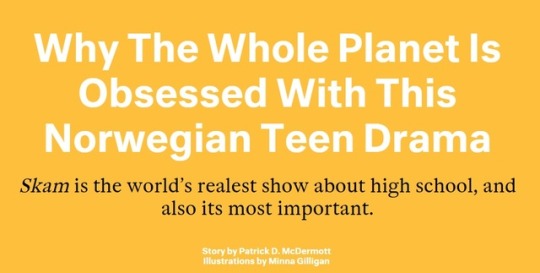
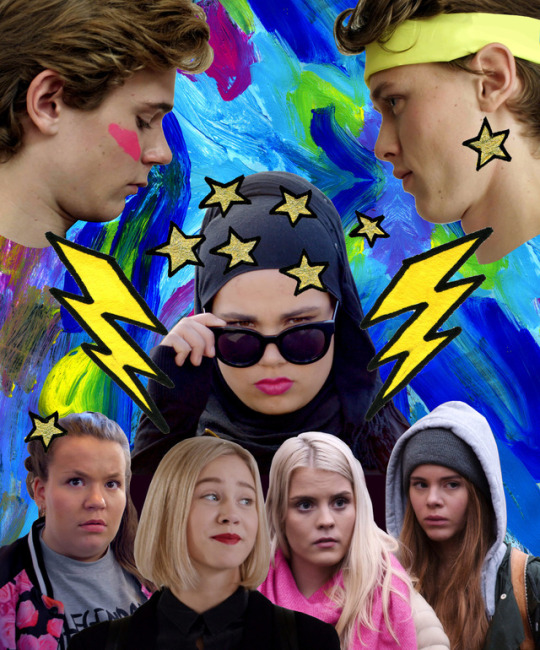
By The Fader .
In Oslo, weekend nights are everything.
That’s partly because of Norway’s strict liquor laws, and also the general social drinking culture, which both tend to encourage weekend binges. People of all ages are normally reserved during the week, keeping their heads down as they go to class and to work, rarely speaking to strangers. Come Friday, though, all bets are off.
In early October 2016, a weekend party was in full swing, at a nice flat with tall ceilings in Grünerløkka, a cool neighborhood in central Oslo. Young, good-looking people were drinking and laughing, talking and flirting. Music was playing loudly — a bass-heavy Norwegian pop song, or maybe something by an American rapper.
At one point, someone started shouting, and asked for the music to be turned down. If this was a bad movie, there might have been a record scratch sound. Following a couple seconds of chaos, it became clear what was happening: a new Skam clip had been posted to the internet. “Oh my God!” someone screamed. “I’m not prepared,” said another. Within minutes, someone had pulled it up on their phone, and the party fell silent for the whole segment, as if collectively hypnotized. Anyone who tried to speak was swiftly shut down. There were no objections: it was time to watch.
That’s exactly how it went down, at least according to Erlend, a scruffy 25-year-old who works in the Norwegian music industry. He lives in Oslo, a.k.a. the birthplace of Skam, a ridiculously popular coming-of-age drama series that depicts the lives of fictional local teenagers. Even though it’s only been around since 2015, Skam, which is produced by NRK, a government-owned public broadcaster, and the biggest media company in Norway, is one of the most adored programs in the nation’s history, with about a quarter of the four million-person population watching each clip. It might also be one of the best TV shows about high school ever made.
Skam, which means “shame” in Norwegian, is released in real-time, with zero warning. If a scene takes place at school on a Tuesday afternoon, the clip goes up on the show’s website Tuesday afternoon. If it takes place at one in the morning at a Saturday night house party, like the first scene of the third season, which Erlend and his friends watched together last year, then it’s uploaded on a Saturday night. At week’s end, the clips, which vary in length but are rarely longer than 15 minutes, are rolled into a single “episode,” which airs on television. For now, if you live outside Scandinavia, the only way to watch Skam is illegally, via fan blogs who upload the episodes, usually to Google Drive or YouTube, and write their own subtitles. In other words: they’re doing God’s work.
Every season of Skam follows a different student at Hartvig Nissen, a real public school in Oslo, where a few of the show’s main actors are actively enrolled. The first season tracks Eva, a nervous, big-hearted 16-year-old who starts high school on the outs from her old clique. Noora, a headstrong feminist who strikes up an unlikely romance up with an older, brawl-starting ladies’ man named William, is at the center of Season 2. Season 3, which aired in the final months of 2016, is all about Isak, a baby-faced teen coming to terms with his sexuality. The fourth season, which began airing the second week of April, is about Sana, a muslim teen who always speaks her mind. The day the trailer dropped, it was announced on Instagram that Sana’s season would be the show’s final one.
Though it’s entirely scripted, Skam is good at blurring the lines between drama and reality. The characters (not the actors) have their own Instagram accounts, which are updated in time with the events of the show, and their fictional text messages, written by 27-year-old web producer Mari Magnus, are posted on the Skam site between clips. Sometimes a short conversation between two characters can stir up more suspense for viewers than a whole episode. The Skam team — headed up by director, screenwriter, and all-around mastermind Julie Andem, 34 — doesn’t allow the cast to do interviews often, partly because they are actually very young, but also because they want to safeguard the show’s tightly wound universe, to preserve the illusion that these characters could almost be real.
Andem, who declined to be interviewed for this piece, doesn’t do very much press either, especially outside of Scandinavia. This strategy has created an uncommonly intense relationship between the show and its audience. Fans invest in the characters' lives as if they were their friends, refreshing frantically, waiting for a clip or a text message as if their own life depended on it. Soap operas have long provided people around the world an escape from everyday traumas. Skam is helping people cope in a new way, by making the real world a more exciting place to be. Of course it’s all just pretend, but sometimes you need to make believe if you want to feel something real.
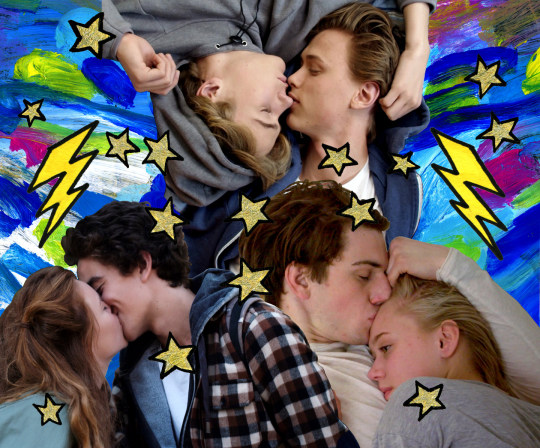
Oslo is frigid in March, and it snows a lot — gently, on and off. For someone whose first window into Norwegian culture was watching Skam bootlegs, exploring the city is kind of like walking through a film set. Bus stops, icy parks, a line of cottages on a slanted street. Everything looks familiar, but in an uncanny sort of way. It’s clean and quiet, especially on weeknights. It’s small, too, presenting itself as its own self-contained little universe, like the inside of a snow globe.
Every person I speak to in Oslo, from the noodle-limbed checkout guy at the corner store to a middle-aged festival organizer visiting from Denmark, knows what Skam is, and most of them have seen it. When I finally meet someone who seemed to know nothing about it — my Airbnb host, a lawyer in her early 30s — it’s actually just a mixup. “Ohhh, I thought you said Scandal or something,” she says, laughing. “I love Skam. I’ve seen every episode.”
No one expected it to get this massive, at least not according to Andreas Blaauw-Hval, a 32-year-old NRK communications manager who, along with his colleague Nathalie Sprus, handles all P.R. for the show. They’re the gatekeepers of the Skam universe, fielding calls from reporters all over the world on a daily basis, and saying “no” to nearly everything. “I think a lot of journalists, and our colleagues in the TV business, find this kind of arrogant,” Blaauw-Hval says. “But it's for the best of the series.”
Sprus and Blaauw-Hval are sitting in a plain-looking coffee shop in Frogner, a pretty neighborhood that feels upscale, but not in an ostentatious way. The café appeared in an episode of Skam once, and it’s just a couple blocks from the high school at which a big bulk of the show is filmed. “It's important to emphasize that the strategy was made before anyone knew how big it would be,” Blaauw-Hval says. “Our job is to try to maintain it, to keep it low-key and exclusive.”
It’s all just pretend, but sometimes you need to make believe if you want to feel something real.
When the show was launched in 2015, it was part of NRK’s attempt to connect with older Norwegian teens who seemed to spend most of their time on Netflix, or caught up in their own lives. Its creator, Julie Andem, who’d previously worked on Jenter, an NRK show for tweens with a similar short-burst real-time release format, was meticulous about accuracy from the get-go. She spent months traveling around and interviewing Norwegian teenagers about everything: sex, drugs, dating, their friends, their fears, their dreams. A lot of the show’s characters were loosely based on real people she met, or composites of several.
Next they started auditions, sitting with 1,200 kids born between 1996 and 2000. “At first people weren’t that interested,” Andem explained in 2016, during a rare TV interview that someone translated and posted on YouTube, in which she comes across as stern but likable. “NRK hadn’t made anything for [older teens], so they were skeptical,” she said. The cast they eventually settled on included a couple locally known child actors, but was dominated by amateur young nobodies, whose raw performances help elevate Skam to greatness. When 19-year-old Lisa Teige, who plays Eva, stresses out over a Facebook message to a potential new friend, it feels not just real, but true.
When it came time to release the first clip, Andem and her team, which includes producer Marianne Furevold-Boland, shared the link with tastemakers from the audition pool, as well as the cast. “The producers wanted the kids to find the series themselves,” says Nathalie Sprus from NRK, 31, who has brown hair with highlights and is almost always smiling. “Their worst nightmare was that a parent would read a news article about ‘this new cool show for kids’ and recommended it to theirs.” Furevold-Boland says this unorthodox, rumor-based strategy “creates loyalty, and a feeling of unity and ownership among teens,” adding that despite its unprecedented success with viewers of all ages, Skam is still made with its teenage target audience in mind.
“I watch Skam because I can relate, to the people and to the parties,” says Henrik, a beer-drunk 21-year-old, in a tented bar beside a church turned concert venue. He speaks in a nasally drawl, like an extra from a Nordic remake of Dazed & Confused. He tells me about russefeiring, the extremely Norwegian tradition in which crews of graduating high schoolers literally purchase a bus to party on for a couple weeks during their final semester. The celebrations, which start after the students turn 18 and can thus can guzzle beer legally, happen all over Norway, but are a huge deal in Oslo specifically. Henrik says kids here often make plans for “russ time” years in advance. Groups have recruited pop singers to record official theme songs for their bus; a bus might spend up to $17,000 USD on music alone, an Oslo-based English-language newspaper reported in 2014.
Russ is a big plot point in Skam. Eva joins a “bus” after her skater boyfriend Jonas encourages her to make new friends. Her search leads her to Noora, a poised new girl with a thing for red lipstick; Vidle, a Type A, russ-obsessed neurotic; Sana, a smart, snarky Muslim teen; and Chris, an unrestrained goofball behind some crucial moments of comic relief. Neither cool nor explicitly uncool, they’re the sort of relatable misfits you can’t help but cheer for. “Just acknowledge that we’re losers,” Sana says to the girls during a russ meeting in the first season. “So you think you’re a loser yourself?” Vidle aks, visibly perturbed. Sana responds: “I'm a Muslim girl in a faithless country — I'm the biggest loser of them all.”
The russ subplot is mostly on the back burner in Season 3, which tells the story of Isak, a confused, self-hating teenager played by a gifted 17-year-old named Tarjei Sandvik Moe, one of the actors who attends Hartvig Nissen in real life. While the earlier seasons hinted that Isak was grappling with something, his sexuality comes to the forefront in this one, which traces his messy romance with Even, a hip, handsome classmate with secrets of his own. All of Skam is gorgeously executed, but it’s Season 3 that feels like straight-up perfect television; you’d be hard pressed to find a more authentic depiction of young queer love. Isak’s realizations, about the tricky business of loving yourself enough to care for someone else too, never feel forced. They come slowly, with lots of help from friends, in a way that feels heartbreakingly true-to-life.
“I think the third season has a really relevant and really clear theme,” explains Elise By Olsen, the 17-year-old editor of an Oslo youth culture magazine called Recens Paper, one afternoon at an indoor food market on the Akerselva river's western bank. Olsen, who is something of a budding fashion icon in Norway, is a big believer that teenagers are more capable than adults give them credit for, and says that she wishes more young people were actively involved in the day-to-day production of Skam. She says she didn’t get into watching the show live until Season 3, which impressed her by tackling issues of sexuality and mental health. “It sort of normalized this stuff, which is quite rare here in Norway,” she explains. Olsen is also friends with some of the cast, including Henrik Holm, who plays Even. “One time he tagged me in a photo and I got, like, 2,000 new followers,” she says.
In Season 2, Noora and William’s will-they-won’t-they arc helped grow the show’s audience, particularly within Norway, but it was the Even and Isak love story that took Skam to the next level. Some truly adorable screenshots of the boys cuddling went viral on Tumblr, which led people across the globe to investigate where it had come from. Now, Skam’s is one of the more voracious TV fandoms in recent memory; in March, Isak and Even came first in E! Online’s fan-picked “TV's Top Couple” contest, by winning millions of votes from fans across the world. “Not bad for a Google Drive show,” one English-speaking stan account tweeted in celebration. “That they managed to win the poll proves there's a very strong engagement,” says Norwegian academic Vilde Schanke Sundet, who has a PhD in television studies from the University of Oslo. “The Norwegians cannot vote alone — you need to get your fan community organized,” she continues. Sundet, who’s working on a post-doctoral study about Skam, says the discourse within the fan community actually mirrors the tone of show, tackling serious topics in a respectful way. There’s a comment section under each official clip, too. “You can check it almost like a newspaper, or your Facebook,” Sundet says.
Part of what makes Skam feel like a news feed is its tight production schedule. According to producer Furevold-Boland, there’s a very short time between idea and execution, which “creates a great energy among the team members,” and also allows the show to respond to real events as they happen. Season 4 will do that by focusing on Sana, who is played confidently by 20-year-old hijabi actress Iman Meskini. “The point was to make a character that chooses her own relation to her religion,” Andem said in that interview on YouTube. “She has strong faith, but she doesn’t need to relate to the whole package the culture is trying to push on her.”
Sana introduces a lot of lofty ideas to Skam, often schooling her friends by offering a different perspective — adding important context to their private dramas without ever diminishing them. “War doesn’t start with violence, it starts with misunderstanding and prejudice,” she tells Noora, whose rigid ideals are challenged throughout the show. “If you say you’re in favor of a world full of peace you actually have to try to understand why others think and act the way they do.”
Despite her typically prickly exterior, Sana has a romantic side, and is an intensely loyal friend. Fans are excited about her season because, from a narrative standpoint, there’s still a lot left to learn about her. But her story feels especially meaningful now, as conversations around islamophobia and xenophobia have never been more urgent, in Scandinavia and beyond. The same day NRK released the trailer for Season 4, a suspected terrorist attack in Stockholm killed four and wounded several others, thrusting Sweden’s open door stance towards migrants and refugees into the global spotlight. In February, Donald Trump blamed a terrorist attack that never happened on Sweden’s liberal immigration policy, and in January he signed a highly contentious and swiftly overturned executive order to keep refugees and immigrants out of the U.S., specifically targeting seven predominantly Muslim nations.
The surprising news that this will be Skam’s last season stings, but if it has to end, Sana’s story feels like a good place to stop — with a reminder that the show isn’t just fodder for insatiable fans, but important, too. Sana isn’t a real person, but she has the potential to be a visible and outspoken role model for real young women, with real stigmas, who have real needs. The trailer for her season is soundtracked by a Nina Simone cover, sung by Yusuf Islam, the artist and convert to Islam formerly known as Cat Stevens. The clip runs in reverse, making the song virtually unrecognizable. Play it forward though, and you’ll hear the words: “I'm just a soul whose intentions are good/ Oh Lord, please don't let me be misunderstood.”
Being a teenager is a beautiful mess. It’s miserable in a lot of ways, but there’s also something strangely poetic about the urgency of it all, the way your little high school world is constantly expanding and collapsing in on itself. Like the greatest shows about teenage life — My So-Called Life, Freaks and Geeks, the sometimes overly schmaltzy Degrassi — Skam never trivializes these feelings.
Even as a 26 year old, I was swept up in Skam straight away. I wish it had been around when I was younger, though I always remind myself it couldn’t have. It’s so inextricably connected to modern digital behavior, which is in itself a hopeful reflection of the things that are good about being young right now, and the way social media has created lifelines for teenagers looking for others who understand them and care what they have to say, whether they’re queer, religious outcasts, or die-hard megafans of a teen drama from Norway.
One of my personal favorite scenes is a quiet one, during which Isak opens up about his sexuality to his best friend Jonas. He tells him that he has romantic feelings for Even after school, over kebabs. Jonas doesn’t flinch; it’s obvious he doesn’t mind who his friend dates. It’s borderline tear-jerking in its casualness, a total non-event. One afternoon, I ride past the kebab shop from that same scene. I pull out my phone to snap a photo of the storefront, and one of the employees in the window, who’s probably getting used to fans appearing out of nowhere, laughs and covers his face.
Later, I walk into an old church with big wooden doors and a clock tower steeple. It’s the setting of another emotional scene from Isak’s season, one that aired a little before Christmas. It features a cameo by Norwegian performance artist Nils Bech, who sings a haunting, Swedish-language rendition of “O Holy Night,” in this very church.
When, on another night, I share a drink with Bech in the back of a crowded bar downtown, he says his cover of the iconic holiday staple was a kind of political statement. He relates the song’s biblical lyrics about God’s son dying for our sins to LGBTQ folk’s long-term struggle for visibility; to him, the words are directed at his gay peers, urging them to think about those who fought for equality before them. “I wanted to say, Hey people! Remember that someone, in a way, died for us to be able to be us!” Like the song, Skam itself is a symbol of how far we’ve come, and a reminder of how much work is left to do.
The reaction to the track was wild, Bech says, with admiring notes from fans and other artists pouring in straight away — a testament to the power of Skam. I asked what he thinks it is about the show that reaches people in such a unique, special way. “When you fall in love, it's always so fucking difficult,” he says, laughing. “And I love the way [Julie Andem] showed that. I think a lot of people watching realized, ‘Oh, it's not about being gay or straight or whatever — love is love.’” He took a sip of beer. “At least that’s why I like it so much.”
Late last year, it was announced that an English-language remake of the show is in the works for U.S. and Canadian audiences, with backing from American Idol producer Simon Fuller. Most Skam fans I talk to are skeptical to say the least, sometimes citing MTV’s tone deaf, too-faithful take on the U.K.’s druggy high school show Skins as an example of just how terribly these translations can go. The real-time rollout and the digital elements can be replicated easily, but the content can’t. “If the show wasn't good, you wouldn't let yourself be so engaged,” Vilde Schanke Sundet tells me.
“I think a lot of people watching realized, ‘Oh, it’s not about being gay or straight or whatever — love is love.’” —Nils Bech
Skam has earned large fan groups in a lot of places, including but not limited to the U.K., the Philippines, China, and the United States. For supporters who stop in from out of town, there is a map of shooting locations on VisitOslo.com, the city’s official travel guide. But there’s occasionally some tension between local fans and tourists, and some Norwegians feel like they understand the show in a more significant way than their international counterparts.
“Norwegian fans are really protective,” Sundet says when we meet in a gift shop near the entrance of The Vigeland Park, a huge sculpture garden full of twisty, snow-covered footpaths, before explaining the unspoken cultural rules known as the Law of Jante, which prohibits citizens from ever thinking they’re superior to anyone else. “They will tell international fans off, saying, ‘You can't go into the school,’ or ‘You need to ask before you take the pictures,’” she explained. “This is a social democracy, so the idea of someone sticking out is strongly bound in our culture. We don't have the kind of superstars that you have in Hollywood.”
That famous and non-famous people have been historically afforded the same level of respect and attention in Norway adds a layer of relatability to Skam, and helps the stories feel more personal. But the show is also a straight-up global phenomenon, one that has pushed the small Nordic society into uncharted waters by complicating these long-standing ideas about what it means to “stick out.” It’s all emblematic of another reason the show is so intoxicating: it’s reflecting back small ways the world is changing, in real time.
One night, I walk around Oslo at dusk. I walk past book shops and clothing stores and chain coffee shops and markets. I walk past churches and houses and apartments and parks. I look at the people who pass me on the street. I look at their bulky scarves and puffy jackets and fuzzy wool gloves. At some point, I start to see the Skam characters in all of their faces.
For one second, I convince myself that I actually do see Henrik Holm — the actor who plays Even, Isak’s dreamy love interest. If it is him, he’s walking fast in the opposite direction, talking into a cell phone and dragging a suitcase behind him. Suddenly, for a split second, we’re right next to each other and out of the corner of my eye, I decide that it’s really him. I’m not positive, but I’m pretty sure. I awkwardly stop walking and whip around, but he’s got long legs and a quick stride, and is already on the next block.
#wow#this was long#skam#articles#the fader#skam cast#usa#to read#season 1#season 2#season 3#season 4
186 notes
·
View notes